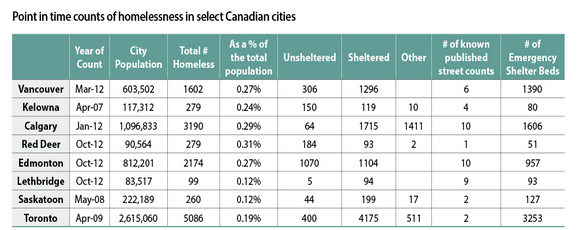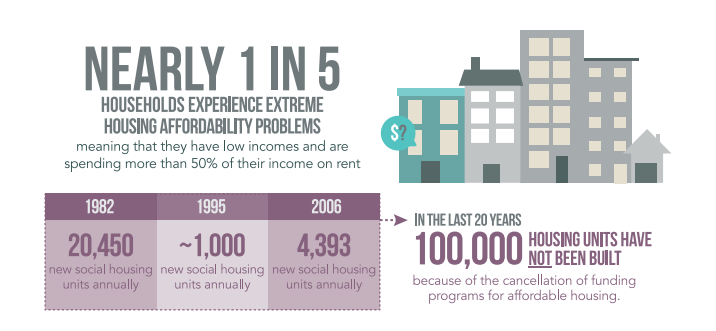Melissa L. asked this question via our latest website survey.
Due to a lack of standardized counts and statistic collection, we don’t have totally concrete numbers on just how many people are homeless and where. (Hopefully, the 2016 HPS Coordinated Point-in-Time Count will help give us a fuller picture.) What we do know is that homelessness is not just an urban problem, though it tends to be most visible in those areas. Homelessness can look very different but occurs in many communities, regions and cities worldwide. (Read the Canadian definition of homelessness to learn more about how we define homelessness and what it can look like.)
Homelessness is hard to quantify due to the complicated and interrelated nature of its causes, which include: systemic failures (ie. poor discharge planning), individual circumstances (ie. family conflict), and/or systemic issues (ie. lack of affordable housing, employment opportunities). In some areas, lack of infrastructure contributes to the kind of homelessness (ie. hidden homelessness is more prevalent in rural and northern parts of Canada due to a lack of shelters, rental and transitional housing) but not the rates overall. To examine all of these factors in a geographical fashion would be a mammoth task! That said, two major factors that contribute to homelessness across the country include population size and housing markets.
Population
Tanya wrote a bit about this last January, explaining that we have to rely on data from cities that do gather information to make estimates and educated guesses. From the data we do have, Canada’s major cities tend to have the highest rates of homelessness. Given the density and large populations of cities, this isn’t surprising. Furthermore, cities tend to have infrastructure and systems around homelessness – more rental housing, non-profit organizations, shelters, soup kitchens, and housing supports – that smaller communities don’t have; often making them a worthwhile destination for people who need extra support.
In the State of Homelessness in Canada 2013 report, the authors pulled point-in-time count data showing that while Toronto, Ontario had the highest number of people experiencing homelessness in general, Red Deer, Alberta had the highest number of people experiencing homelessness per capita.
Because of how limited existing data is – point-in-time counts typically only enumerate unsheltered and sheltered homeless populations and miss people who are precariously housed or hidden homeless – causation is hard to determine.
Even though cities tend to have more jobs and social opportunities – Toronto, for example, is often viewed as a “safe haven” for LGBTQ2 youth seeking community and a sense of belonging – living in them tends to come with a high price tag due to tight and inflated housing markets.
Housing markets
The value placed on private property ownership means that when demand goes up for housing, so do prices – which encourages policymakers and development companies to favour strategies for private home ownership over affordable rental housing. As a result, we have very strained housing markets, especially for people in working classes and/or living in poverty.
Just this week, the municipal government in Portland, Oregon put forward a motion to declare homelessness an emergency – the goal being to fast-track rent control and inclusionary zoning. In Portland, a constant influx of residents and a mere 3% vacancy rate have been driving rents upward by 20% over the past 5 years. Similar trends have been noted in Toronto, Ontario and Vancouver, British Columbia – now the two most expensive cities to live in Canada.
According to data from the Homeless Hub’s 2014 report, nearly 1 in 5 households experience extreme housing affordability problems. According to the CHRA, the rates of renters in extreme core housing need – meaning, paying more than 50% of their income on housing – are: Vancouver at 22%, in Halifax at 21%, in Toronto, Edmonton and St. John’s at 20%, and Montreal at 19%. As the same report proposed, the only way to ease limited vacancy and end homelessness is to invest in affordable housing.
This post is part of our Friday "Ask the Hub" blog series. Have a homeless-related question you want answered? E-mail us at thehub@edu.yorku.ca and we will provide a research-based answer.



